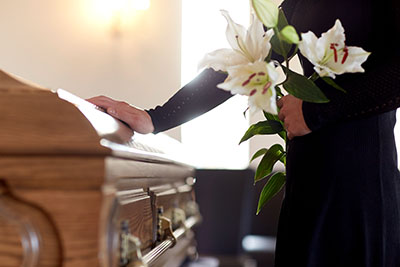Options for Body Disposition After Death
Last updated December 2021
There are several options for disposing of a deceased person’s remains.
 Burial
Burial
Burial is the traditional choice. It can be done directly, with no viewing or ceremonies, or with any combination of viewing, ceremony, and graveside service. It usually requires a casket; cemetery plot; fees to open and close the grave; cemetery endowment (upkeep); and a marker, monument, or headstone. Though most burials are below ground, another usually more expensive option is burial above ground in a mausoleum.
Immediate burial is the least expensive option: A funeral home files the necessary paperwork, places the unembalmed body in a casket, and takes the remains to a cemetery for burial, usually within one day. This alternative eliminates expenses for embalming and some expenses for funeral home facilities, and most families choose a lower-priced casket.
Cremation
Cremation is an increasingly popular choice. Usually neither a casket nor embalming is required, but if the body must be held for several days, refrigeration or embalming may be necessary. Cremation, like burial, can be direct or following a funeral. It is also possible to have an embalming, viewing, and ceremony followed by cremation. Some funeral homes offer rental caskets for cremation, while others sell modest caskets designed for cremation. Cremation also allows flexibility as to when or where services are held—many families now hold memorial services in their own homes or at the deceased’s favorite place.
Cremated remains (“cremains”) may be scattered, kept at home, buried in a cemetery, or interred in a columbarium (an above-ground structure containing permanent niches). Burial in a cemetery or placement in a columbarium adds to the cost.
Donation
Whether a body is to be buried or cremated, part or all of it can first be donated, to improve the quality of life of others or offer the gift of life itself. Donation of at least some body parts is an option for almost anyone, regardless of age or medical history.
Individuals can donate organs or tissues or their whole bodies. If you wish to become a donor, have your intent to be an organ donor indicated on your driver’s license. Or register online with Donate Life America. It’s also a good idea to fill out an organ donor card and carry it with you at all times. And inform your family of your wishes. Permission of next of kin is required before donation.
If you wish to make a whole body donation, it’s necessary to make prior arrangements with a medical school. With the exception of removing corneas, whole body donation usually precludes the donation of individual organs or tissues for transplants.
After organ and tissue donation, you still need to make funeral arrangements. If you want to donate your body to a medical school, your family likely will have to pay to transport your body and for eventual disposal by cremation or burial.


